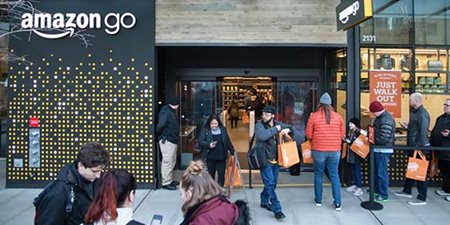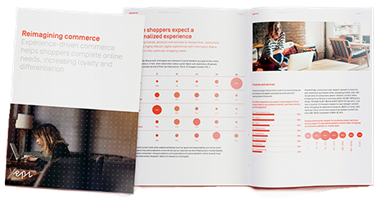The Amazon Effect and Online Shopping are Not Killing Retail
By Laura Myers
June 22, 2018
Amazon, customer experience, Customer Journey, Customer Service, ecommerce, Episerver, gartner, GDPR, omnichannel, online advertising, online store, personalization, Retail, Retail Communications
Retail is not dead, or gasping for breath as it falls victim to the big bad online commerce world even  though the narrative surrounding store closures has many believing this to be true. Retail is in fact thriving as it evolves to be more about experience and less about a simple purchase of goods and services.
though the narrative surrounding store closures has many believing this to be true. Retail is in fact thriving as it evolves to be more about experience and less about a simple purchase of goods and services.
Yes, retail stores are closing and more incumbent brands are filing for bankruptcy than ever before but in reality, many analysts have predicted this shift for years given the overabundance of retail space per capita in the U.S compared to the rest of the world. In 2017 the United States had 23.5 square feet of retail space per person, versus Canada with 16.4 per person, and Australia with 11.1, I would say with more than double that of its third largest retail counterpart, the U.S had retail space to spare.
Admittedly the “Amazon Effect” has been a driving force behind the massive disruption in the way we shop, so much so that the Supreme Court recently ruled “states have the right to collect sales taxes on internet companies that do not have a physical presence in their states.” This is an attempt to level out the retail playing field so to speak but it could be giving a false sense of resolution and distract from the real reasons some businessess are struggling with in-store sales.
With Gartner recently releasing their Magic Quadrant for Digital Commerce, I thought it best to speak with Senior Director of Commerce, Ed Kennedy from Episerver, a vendor featured in the report to share his commentary on some questions commonly circulating in the “retail apocalypse” conversation.
This Isn't the First Time Retail has Changed
Laura: Do you think eCommerce is as much to blame for the ‘death of retail’ as it is made out to be? And what do you think the biggest contributing factors have been?
Ed: Ecommerce is not to blame for the ‘death of retail,’ because retail is not dead or dying. Retail has  been healthy for more than eight years. Since 2010, retail sales have grown from 2 percent to 8 percent annually. Specific retailers have gone out of business but it’s often because of failure to transition to an experience-driven retailer from a transaction or price-centered retailer. Ecommerce gave consumers unlimited access to products and price transparency, which drove many mediocre retailers out of business. It became easier to find better products online at lower prices than now defunct retailers were delivering. It’s death in the middle. The retailers that are succeeding are either “Everyday Low Price” (EDLPs) retailers such as Target and Walmart or retailers that create highly valuable experiences both online and in-store.
been healthy for more than eight years. Since 2010, retail sales have grown from 2 percent to 8 percent annually. Specific retailers have gone out of business but it’s often because of failure to transition to an experience-driven retailer from a transaction or price-centered retailer. Ecommerce gave consumers unlimited access to products and price transparency, which drove many mediocre retailers out of business. It became easier to find better products online at lower prices than now defunct retailers were delivering. It’s death in the middle. The retailers that are succeeding are either “Everyday Low Price” (EDLPs) retailers such as Target and Walmart or retailers that create highly valuable experiences both online and in-store.
What we’re seeing isn’t a death, but an evolution. Retail can and has taken many different shapes throughout history -- from the street merchant model of the Renaissance to catalogue-only mail order models of the mid-20th century. While the explosion in digital technologies and devices in recent years has certainly transformed the landscape, it’s also proliferated the number of ways consumers shop and make purchases, which can work in retailers’ favor.
That being said, shopping is no longer about the purchase, but rather the overall experience. For this reason, a negative online experience can lead to a negative brand perception. There are several elements that determine overall customer experience -- from the capabilities of a mobile app to the accuracy of online product recommendations to the cadence of marketing emails and convenience of in-store experiences. In today’s highly connected world, customers interact with brands across a variety of channels and touchpoints, which together create the modern customer experience and determine how successful a brand will be based on the degree of seamlessness and relevancy it offers.
Brick and Mortar Offer More than Sales
Laura: What do you think of online retailers moving to brick and mortar locations, will they be as successful?
Ed: It makes complete sense for online-only retailers to have physical locations. Physical retail still has several advantages over online including convenience, speed to consumption and tangible product experiences. Online retailers such as Amazon and Warby Parker opening physical stores may eat into their profitability but they gain brand and market presence that can increase sales both online and in-store. Furthermore, physical stores give online retailers a collection and distribution point for online purchases, which provides a convenient service for consumers and helps control continuously rising shipping costs.
Moving to physical locations that complement the Web experience shows that these brands are willing to invest in the customer experience, which sets them apart from those not accounting for shoppers’ diverse expectations and needs. In the same breath, however, it’s important for digital-first retailers to understand that when they open their physical doors to shoppers, their online crowd will expect a technology-driven experience. They will be more open to trying features like smart mirrors, in-store kiosks and other self-serve type functionality.
Regardless of Location, Know Your Customer
Laura: What are your key foundational principles for brands in building a successful online/offline experience?
Ed: Brands and retailers must understand their customer and how their product is woven into the consumer’s life. This is tried-and-true business strategy that now needs to evolve to meet consumers in their digital lives. Specifically, brands and retailers need to build profiles of their consumers wherever that consumer engages (online, in-store, social) and at whatever stage (known or unknown). In doing so, they can use these profiles to learn about which customer journeys are successful and unsuccessful and target personalized offers, content, and product recommendations through the consumer’s journey, including between channels (online and offline). Bottom line, brands and retailers need to get their customer data centralized and enriched to compete. This unlocks a tremendous amount of value between online and offline including the ability to recommend products to consumers in-store based on their web  behavior and vice versa. Retailers and brands can also use this data to target high-value promotions and exclusive offers to consumers who have engaged online but have not yet visited a store.
behavior and vice versa. Retailers and brands can also use this data to target high-value promotions and exclusive offers to consumers who have engaged online but have not yet visited a store.
To build a successful omnichannel experience, retailers need to gain a competitive advantage by using their resources to offer a unique experience and investing in personalization across channels and devices. Personalization is key for strong brand relationships and involves identifying individual users to create more personal experiences by providing the pathways relevant to them.
According to some of our recent research, personalization also heavily influences brand perception. In fact, over a third of shoppers (35 percent) feel brands do not care enough about personalizing their shopping experiences, causing them to feel disappointed, frustrated and distrustful. Therefore, it is especially important for companies to offer consumers a one-of-a-kind experience every time they interact with a brand to boost customer loyalty and build a strong relationship.
Laura: What technologies do you think are pivotal in helping them achieve that?
Ed: It’s becoming more important that retailers and consumer brands invest in a Customer Data Platform (CDP) that tracks and stores customer data anonymously and identifies consumers who visit their ecommerce website. Brands need to enrich this data platform with consumer data from their email marketing solution, CRM, and loyalty programs.
Upon this foundation, brands and retailers can leverage automated personalization technologies such as product recommendation engines, content recommendation engines, and promotion targeting to optimize what consumers will see in various stages of their journey and in which channel. Brands, however, should work with vendors who take a consent-based approach to data processing and processes as personalization and privacy are parallel conversations under General Data Protection Regulation.
Who Excels at Leveraging Modern Retail?
Laura: Which brands do you think have an awesome online/offline strategy?
Ed: One brand with a strong multichannel strategy is Starbucks, which helped pioneer mobile payments and seamlessly bridges the online and in-store experiences with its order ahead options. Not only do they engage with consumers through their mobile ordering app and personalized offers, but they also offer in-store incentives such as free WiFi and free refills on tea and coffee. The hidden value for Starbucks is all the rich consumer data they are soaking up about consumer preferences or dislikes, behavior, order frequency and location. Their app and stores give consumers a great experience while Starbucks benefits from the massive influx of customer data including that can be sourced from its loyalty program.
For brands to succeed in today’s highly competitive retail landscape where consumers are recognizing tactics like personalization and retargeting, they must follow the lead of savvy brands and deliver an experience that is so convenient across channels that consumers welcome the marketing aspect of it.
Ending Notes
Yes, buying behaviors have changed and online shopping has risen in appeal due to its ease of use and on-demand nature but in addition, many consumers are finding a larger percentage of their disposable income going towards entertainment and experience driven purchases, with items such as clothing and furnishings becoming secondary. The reasoning behind this is far more based on generational preferences and if an online influence were to blame it would be more social media than ecommerce.
Another reason for many closed store-fronts entirely unrelated to online commerce is a boom in real-estate both with the rise in purchase of short-term rental properties and the development of many beautiful new neighborhoods drawing in optimistic retailers who line the streets and are met with emptiness. If a high percentage of properties are purchased by owners who don’t occupy most of the year, foot traffic in many neighborhoods could slow to far less than anticipated by local business owners.
However, as Ed mentions, brick and mortar retail will always have a place. If it didn’t then agile brands like Amazon, Warby Parker etc wouldn’t be making the jump from online to offline if they didn’t see an inherent value. It may be their digitally native beginning that has set them apart in better understanding how to leverage both the online and offline but I don’t think that is the stringent recipe for success. The astounding capabilities of commerce technologies are making the process faster, easier, more personal and intelligent with an impressive ability to scale but if you strip that all away, the winning brands are still the ones that understand their customers, hone in on just what they need and serve it up within a great and lasting experience, I don't see that changing any time soon.

Laura Myers
A digital business, marketing and social media enthusiast, Laura thrives on asking unique, insightful questions to ignite conversation. At an event or remotely, she enjoys any opportunity to connect with like-minded people in the industry.